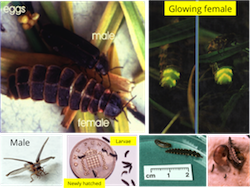Glowworms
It is glowworm season
World firefly day July 7-8: Click here WFfday
Here are some UK glowworms

See a video here of females glowing in July
Glowworms are amazing. They are bioluminescent beetles. The female glows during June and July, and sometimes August, to attract a mate. Once it has mated it stops glowing, and lays its eggs a few days later, and then dies. The larvae hatch in about 3 weeks time. These flash when disturbed as a warning – do not eat me I taste horrible. The UK glowworms are closely related to fireflies. There are two species in Britain – Lampyrus noctiluca and Phosphaenus hemiptera (very rare, mate be extinct here). However the famous New Zealand glowworm is actually the larva of a fly, several similar species being found in Australia.
The light is produced by a chemical reaction – burning without fire, all the energy going into making cold light and no heat. The energy for All bioluminescence comes from oxidation. A small organic molecule, called a luciferin, is oxidised by oxygen the reaction being catalysed by a protein called a luciferase. Each animal group uses a completely different luciferase. The luciferin used by glowworms and fireflies is only used by them. Luminous jelly fish, shrimp, and copepods use a completely different luciferin called coelenterazine. Darwin had major problems with bioluminescence. He could not see how small change by small change could lead to a new phenomenon. In fact the first entry in his Beagle notebook was bioluminescence off the coast of Tenerife, caused by microscopic dinoflagellates. But we have solved this. Bioluminescence turns out to be a model for one of the greatest puzzles in evolution – the origin of a new enzyme (see Campbell, A. K. 2012. Darwin shines light on the evolution of bioluminescence. Luminescence, 27, 447-449 – pdf available on request).
Amazingly bioluminescence has revolutionised biomedical research, clinical diagnosis, drug discovery and created three individual billion dollar markets.
email us any you have seen to info@theyoungdarwinian.com
See the Uk’s glowworm site set up by Robin Scagell http://glowworms.org.uk for sites near you. You must wait till it is very dark, for example after 10.30 at night.
Also see these sites
http://www.glowworms.org.uk/Tylerbookpt1
htmlhttp://glowworms.org.uk
It is World Firefly day this week, Se
https://fireflyersinternational.net/world-firefly-day/
https://fireflyersinternational.net/
Some useful references
- Campbell AK (2003). Rainbow Makers. Chemistry in Britain June 2003:30-33
- Campbell AK (2017). Fundamentals of intracellular calcium, Wiley, Chichester.
- Campbell, A. K. 2003a. Save those molecules! Molecular biodiversity and life. Journal of Applied Ecology, 40, 193-203.
- Campbell, A. K. 2003b. What Darwin missed. Astrophysics and Space Science, 285, 571-585.
- Campbell, A. K. 2012. Darwin shines light on the evolution of bioluminescence. Luminescence, 27, 447-449.
- Campbell, A. K. 2015. Intracellular Calcium, Vols 1 and 2. Intracellular Calcium.
- Campbell, A. K. 2018. Fundamentals of intracellular calcium, Chichester, Wiley.
- Campbell, AK (2015). Intracellular calcium. ISBN 978-0470-695-111. Wiley, Chichester.
- Campbell,AK. (1988). Chemiluminescence: principles and applications in biology and medicine, pp608. Horwood/VCH, Chichester and Weinheim. ISBN 3-527-26342-X. 0 7156 2499 7.
- Campbell,AK. (1994). Rubicon: the fifth dimension of biology. pp 304. Duckworth, London, 0 7156 2499 7.
- Herring,PJ, Campbell,AK, Whitfield, M and Maddock, L (eds) (1990). Light and Life in the Sea. pp 357. Cambridge University Press, Cambridge.
- Sala-Newby, GB, Thomson, CM and Campbell, AK (1996). Biochem. J. 313: 761-767. Sequence and biochemical similarities between luciferases of the glow-worm Lampyris noctiluca and the firefly Photinus pyralis.
- Tyler, J (2002). Glowworms. ISBN: 9780952352617
- Vassel, N, Cox, CD, Morse, V, Powell, R, Evans, R, Brancale, A, Wann, KT and Campbell, AK (2012). Enzymatic activity of albumin shown by coelenterazine chemiluminescence. Luminescence 27, 234-241.
1 Comment
| The Biolumi Blog
[…] Glowworms […]